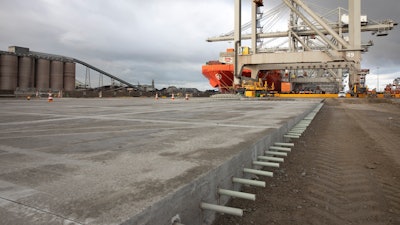Why Composites are Reinventing Building And Construction Products
Why Composites are Reinventing Building And Construction Products
Blog Article
Discovering the Uses and Advantages of Recycled Composites in Modern Industries
The combinations of recycled materials with sophisticated composite technologies presents an encouraging opportunity for enhancing sustainability, resilience, and cost-efficiency throughout various sectors. As sectors look for innovative options to address ecological concerns and enhance functional performances, the consolidation of recycled compounds emerges as an engaging option.
Environmental Benefits of Recycled Composites
The use of recycled composites in modern-day industries offers considerable ecological benefits, adding to the decrease of waste and the conservation of natural deposits. By integrating recycled composites into producing procedures, sectors can lower their dependence on virgin materials, thus reducing the amount of waste generated and the power needed for removal and manufacturing. This change in the direction of making use of recycled composites aids in diverting materials from landfills, minimizing the problem on waste administration systems, and reducing greenhouse gas exhausts related to typical manufacturing techniques.
Additionally, making use of recycled compounds advertises the preservation of natural deposits such as timber, minerals, and water, which are often depleted through the removal and processing of basic materials (composites). By expanding the life expectancy of materials via recycling, sectors can aid preserve communities and biodiversity by lowering the need for new sources. Generally, the adoption of recycled compounds in contemporary industries plays an important role in advertising sustainability and alleviating the ecological influence of production procedures
Improved Durability in Item Manufacturing
With a concentrate on longevity and effectiveness, incorporating recycled compounds right into product production processes improves sturdiness and sustainability. By using recycled composites, manufacturers can produce items that are not only strong yet additionally immune to tear and wear, making them excellent for long-term usage in numerous markets. The mix of different materials in recycled compounds can typically result in boosted strength and toughness compared to standard products, providing a cost-effective option for generating lasting products.
Among the essential advantages of making use of recycled compounds in product manufacturing is the capacity to tailor the material homes to satisfy details resilience demands. By adjusting the composition and manufacturing techniques, makers can customize the recycled composites to stand up to harsh environmental conditions, heavy loads, or frequent use without jeopardizing on efficiency. This adaptability in layout and manufacturing enables the development of extremely long lasting items that preserve their honesty with time, reducing the demand for constant substitutes and inevitably adding to an extra lasting manufacturing procedure.
Cost-Effectiveness and Financial Benefits
Incorporating recycled compounds into item manufacturing not only improves sturdiness and sustainability but likewise uses substantial cost-effectiveness and financial advantages. Making use of recycled compounds can result in decreased product costs as recycled materials are frequently cheaper than virgin products. In addition, recycling composite products can lower garbage disposal expenditures and lower the demand for landfill space, adding to total price financial savings for markets.

Innovation and Style Adaptability With Recycled Composites
Utilizing recycled compounds in contemporary industries offers unparalleled possibilities for technology and style versatility. By incorporating recycled materials into composite manufacturing procedures, companies can press the limits of traditional style constraints and discover new opportunities. The convenience of recycled composites enables the creation of intricate shapes and frameworks that may not be possible with standard products.
Among the essential benefits of recycled composites is their capacity to be formed right into various types, giving developers the liberty to explore special sizes and shapes. composites. This versatility opens a world of imaginative chances, enabling the advancement of light-weight yet durable products that fulfill the particular demands of various industries
Furthermore, using recycled composites advertises sustainable techniques and supports the round economic situation by lowering waste and lessening the ecological influence of producing procedures. This focus on eco-friendly layout options aligns with the expanding trend in the direction of sustainability in modern sectors, making recycled composites an important source for forward-thinking and cutting-edge companies.
Applications Across Different Industries
Recycled compounds locate impactful and varied applications across a vast array of industries because of their one-of-a-kind homes and sustainability benefits. In the automotive market, these products are progressively utilized for producing light-weight and long lasting parts, enhancing fuel effectiveness and reducing carbon discharges. The aerospace sector gain from recycled compounds in the manufacturing of aircraft parts, where the products' strength-to-weight ratio is critical for making sure safety and security and performance. In building, these compounds are made use of for creating strong yet environment-friendly structure materials, contributing to sustainable infrastructure advancement. The renewable resource sector employs recycled compounds in wind turbine blades and photovoltaic panels, using their stamina and resistance to severe ecological problems. Additionally, the aquatic market utilizes these click products for producing boat hulls and components, supplying enhanced sturdiness and corrosion resistance. The versatility and sustainability of recycled composites make them beneficial throughout numerous markets, driving advancement and environmental stewardship. composites.
Conclusion
To conclude, the utilization of recycled composites in modern industries uses why not find out more significant environmental advantages, enhanced durability in product production, cost-effectiveness, and economic benefits. Additionally, the usage of recycled compounds permits for advancement and layout flexibility throughout various industries. In general, the fostering of recycled compounds offers a sustainable and functional remedy for meeting the requirements of the sector while also decreasing environmental influence.

One of the key advantages of making use of recycled compounds in product manufacturing is the capability to tailor the product homes to satisfy certain durability requirements. Using recycled compounds can lead to lowered product prices as recycled products are commonly much less expensive than virgin products. The aerospace market benefits from recycled compounds in the production of airplane parts, where the products' strength-to-weight proportion is crucial for making certain security and efficiency.
Report this page